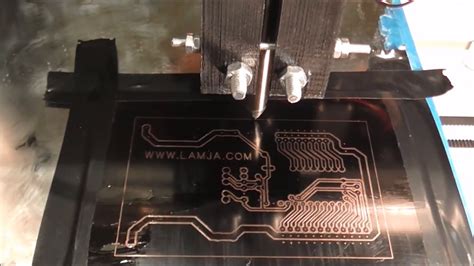Introduction to PCB Printers
Printed Circuit Board (PCB) printers are specialized machines that enable the rapid prototyping and production of custom PCBs. These printers have revolutionized the electronics industry by allowing engineers, hobbyists, and businesses to create high-quality PCBs in-house, reducing lead times and costs associated with outsourcing PCB fabrication.
In this article, we will compare different types of PCB printers, their features, advantages, and disadvantages to help you determine which PCB printer is best suited for your needs.
Types of PCB Printers
There are several types of PCB printers available in the market, each with its own unique features and capabilities. The most common types of PCB printers include:
Inkjet PCB Printers
Inkjet PCB printers use a modified inkjet printing technology to deposit conductive ink onto the PCB substrate. These printers are known for their affordability, ease of use, and ability to print complex designs with fine traces.
Advantages of Inkjet PCB Printers
- Low initial investment cost
- User-friendly operation
- Suitable for rapid prototyping and low-volume production
- Can print on a variety of substrates, including flexible materials
Disadvantages of Inkjet PCB Printers
- Limited layer count (usually single or double-sided PCBs)
- Slower printing speed compared to other technologies
- Requires post-processing (curing) of the conductive ink
Direct Imaging (DI) PCB Printers
Direct Imaging (DI) PCB printers use a high-resolution digital imaging system to directly expose the PCB substrate with the desired circuit pattern. This technology eliminates the need for traditional photomasks, reducing the time and cost associated with PCB fabrication.
Advantages of DI PCB Printers
- High-resolution printing (up to 25 microns)
- Fast printing speed
- Suitable for high-volume production
- Supports multi-layer PCBs
Disadvantages of DI PCB Printers
- High initial investment cost
- Requires skilled operators
- Limited substrate flexibility
3D PCB Printers
3D PCB printers combine additive manufacturing technology with conductive materials to create three-dimensional PCBs. These printers enable the fabrication of complex, non-planar PCB designs that are difficult or impossible to achieve with traditional manufacturing methods.
Advantages of 3D PCB Printers
- Ability to create complex, three-dimensional PCB structures
- Enables the integration of electronic components within the PCB
- Reduces the need for manual assembly
Disadvantages of 3D PCB Printers
- High initial investment cost
- Limited material options
- Slower printing speed compared to other technologies
Comparison Table
| PCB Printer Type | Resolution | Speed | Cost | Substrate Flexibility | Layer Count |
|---|---|---|---|---|---|
| Inkjet | Medium | Slow | Low | High | Low |
| Direct Imaging | High | Fast | High | Low | High |
| 3D | High | Slow | High | High | N/A |

Factors to Consider When Choosing a PCB Printer
When selecting a PCB printer, there are several factors to consider to ensure that the printer meets your specific requirements. These factors include:
Resolution and Trace Width
The resolution and minimum trace width of a PCB printer determine the level of detail and complexity that can be achieved in the printed circuit patterns. Higher resolution printers can produce finer traces and more intricate designs.
Printing Speed
The printing speed of a PCB printer directly impacts the production throughput. Faster printers can reduce the time required to fabricate PCBs, making them suitable for high-volume production.
Cost
The cost of a PCB printer includes both the initial investment and the ongoing operational expenses, such as consumables and maintenance. It is important to consider the total cost of ownership when evaluating different PCB printers.
Substrate Compatibility
Different PCB printers support various substrate materials, including rigid and flexible PCBs. Ensure that the printer you choose is compatible with the substrates you plan to use.
Layer Count
The number of layers a PCB printer can fabricate is an important consideration for projects that require multi-layer PCBs. Some printers are limited to single or double-sided PCBs, while others can produce multi-layer boards.
Frequently Asked Questions (FAQ)
-
Q: What is the difference between inkjet and direct imaging PCB printers?
A: Inkjet PCB printers use conductive ink to print circuit patterns, while direct imaging printers use a digital imaging system to directly expose the PCB substrate. Inkjet printers are more affordable and flexible, while direct imaging printers offer higher resolution and faster printing speeds. -
Q: Can 3D PCB printers create multi-layer boards?
A: 3D PCB printers create three-dimensional PCB structures, which do not follow the traditional layer-based approach. Instead, they can integrate electronic components within the PCB structure. -
Q: Are PCB printers suitable for high-volume production?
A: The suitability of a PCB printer for high-volume production depends on its printing speed and technology. Direct imaging printers are generally better suited for high-volume production due to their faster printing speeds. -
Q: Can PCB printers work with flexible substrates?
A: Some PCB printers, such as inkjet printers, are compatible with flexible substrates. However, the substrate compatibility varies among different printer types and models. -
Q: What is the typical resolution of a PCB printer?
A: The resolution of a PCB printer varies depending on the technology used. Inkjet printers typically have a medium resolution, while direct imaging and 3D printers can achieve higher resolutions, often up to 25 microns or better.
Conclusion
Choosing the right PCB printer depends on your specific requirements, budget, and production needs. Inkjet PCB printers offer affordability and flexibility, making them suitable for rapid prototyping and low-volume production. Direct imaging printers provide high resolution and fast printing speeds, ideal for high-volume production. 3D PCB printers enable the creation of complex, three-dimensional PCB structures, opening up new possibilities in PCB design.
By considering factors such as resolution, printing speed, cost, substrate compatibility, and layer count, you can select the PCB printer that best aligns with your project goals. As technology continues to advance, PCB printers will likely become more accessible, efficient, and capable of meeting the evolving needs of the electronics industry.

No responses yet